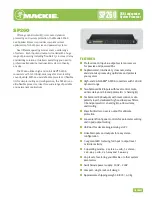
Technical Reference Manual – SB-293
01838-002 Rev. 3.0
Printing Date
Page 12 of 32
July-1998
controller then responds to this state change and generates an output (such as unlocking the door to
allow egress).
Door Status Switch Input
The door status switch input accepts a signal from a normally closed input switch that indicates the
status of the door: open or closed. While the door remains closed, the switch remains closed. When
someone opens the door, the door switch is opened, breaking the circuit and generating a state
change. The controller responds to this state change and generates an alarm output if the door is
forced or held open too long. Refer to Figure 9 on page 18 for a typical door status switch wiring
diagram.
NOTE: If the satellite board is configured for second door control and the door status switch is not
being used, install a jumper across pins 1 and 2 of TB-8 to prevent a continuous door open alarm
from being received by the controller.
NOTE: When using a door status input, the door must also have a Request to Exit input for proper
operation/annunciation of Door Forced and Door Held Open alarms.
Request to Exit
The request to exit (RTE) input accepts signals from a normally open input device that indicates that
a request has been made for someone to exit a secured door. Motion detectors, pressure-sensitive
floor mats, or push buttons may make RTE requests. While there is no one there to activate the RTE
request, the input remains open. When someone desires to exit through a secure door, they activate
the RTE device, closing the circuit and generating a state change. The controller then responds to
this state change and generates an output unlocking the door to allow egress. Refer to Figure 10 on
page 19 for a typical RTE wiring diagram.
General Purpose Inputs
The general-purpose input accepts signals from either a normally closed or a normally open input
device that indicates when a change in state has occurred.
For a normally closed input device, while the input device is in its normal state the general-purpose
input circuit remains closed. When the input device is activated, the general-purpose input circuit is
opened generating a state change. The controller may respond to this state change per programmed
instructions. The general-purpose input is configured through the
Doors32™
access control software.
A normally closed push-button may be used to provide a normally closed general-purpose input.
While the push button is in its normal state, the normally closed circuit is complete and no input signal
is generated at the controller. When a user presses the push button it opens the general-purpose
input circuit and generates a state change. The controller responds to this state change per
programmed instructions and may perform some action. Refer to either Figure 12 on page 20 or
Figure 16 on page 23 for a typical general-purpose normally closed input wiring diagram.
For a normally open input device, while the input device is in its normal state, the general-purpose
input circuit remains open. When the input device is activated, the general-purpose input circuit is
closed generating a state change. The controller may respond to this state change per programmed
instructions. The general-purpose input is configured through the
Doors32™
access control software.
A normally open motion detector may be used to provide a normally open general-purpose input. If
the motion detector does not detect motion, its alarm circuit remains open and no input signal is
generated at the controller. When the motion detector does detect someone entering its controlled
area, its alarm circuit closes, completing the general-purpose input circuit and generating a state
change. The controller responds to this state change per programmed instructions and may perform
some action. Refer to Figure 12 on page 20 or Figure 15 on page 23 for a typical general-purpose
normally open input wiring diagram.
SYSTEM INSTALLATION












































